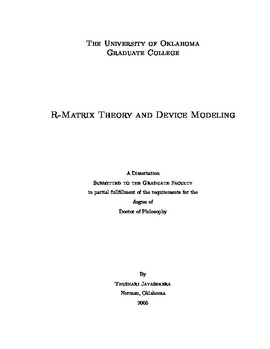| dc.contributor.advisor | Mullen, Kieran J., | en_US |
| dc.contributor.author | Jayasekera, Thushari. | en_US |
| dc.date.accessioned | 2013-08-16T12:19:55Z | |
| dc.date.available | 2013-08-16T12:19:55Z | |
| dc.date.issued | 2005 | en_US |
| dc.identifier.uri | https://hdl.handle.net/11244/924 | |
| dc.description.abstract | Novel experimental techniques allow us to fabricate very small semiconductor devices such that the electron mean free path is larger than the size of the device. The macroscopic properties of these quantum mechanical devices can be calculated using the Landauer formula, which requires as input the transmission coefficients of electrons in the device. We mainly focus on InSb-based devices in which the effective mass is very small ( m* = 0.0139 m0, where m 0 is the free electron mass). Since the gaps between electron subband levels in such devices are large that these devices are more likely to behave in a fully quantum mechanical fashion. Thus it is important to calculate the transmission coefficients of electrons in such a device quantum mechanically. | en_US |
| dc.description.abstract | To illustrate the usefulness of this theory, we propose a new device that uses the evaporative emission of electrons to cool an electron-gas system. Our model is based on filtering electron subbands in a quantum-wire device. When electrons in higher subbands scatter out of the initial electron distribution, the system comes to equilibrium at a different chemical potential and a different temperature than the initial system. To study cooling in this system, we apply the Landauer formula. To calculate the transmission coefficients we use RMT. Our calculation shows that we can find device geometries for which this new equilibrium temperature is about 15% less than the initial temperature. We present experimental parameters for such a cooling device with InSb and GaAs. (Abstract shortened by UMI.) | en_US |
| dc.description.abstract | To calculate the transmission coefficients, we use R-matrix theory (RMT), a technique that was first introduced in nuclear physics, and later applied in atomic and molecular physics, and that has recently been shown to be a useful tool for calcu lating the transport properties of solid-state devices. We have improved upon the existing implementations of RMT in device physics by introducing a procedure that dramatically speeds the convergence. This approach is called variational R-matrix theory. Moreover, we have extended the R-matrix formalism to scattering systems with very complicated device geometries. The new formalism, which we call "the R matrix connection formula" can be used to calculate the transport properties of practical solid-state devices. Our variational device R-matrix theory is a very accurate, efficient way to calculate transmission coefficients of electrons in such a device. We discuss the applications of RMT to modeling of new experimental devices and explain existing experimental observations. | en_US |
| dc.format.extent | xxxii, 166 leaves : | en_US |
| dc.subject | Semiconductors. | en_US |
| dc.subject | R-matrices. | en_US |
| dc.subject | Physics, Condensed Matter. | en_US |
| dc.title | R-matrix theory and device modeling. | en_US |
| dc.type | Thesis | en_US |
| dc.thesis.degree | Ph.D. | en_US |
| dc.thesis.degreeDiscipline | Homer L. Dodge Department of Physics and Astronomy | en_US |
| dc.note | Source: Dissertation Abstracts International, Volume: 66-12, Section: B, page: 6685. | en_US |
| dc.note | Adviser: Kieran J. Mullen. | en_US |
| ou.identifier | (UMI)AAI3203284 | en_US |
| ou.group | College of Arts and Sciences::Homer L. Dodge Department of Physics and Astronomy | |
